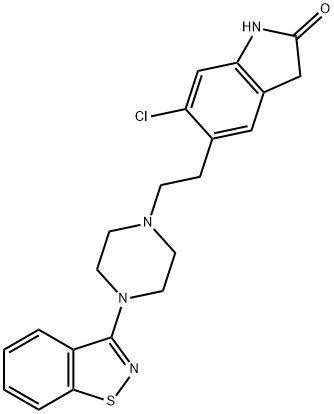| Atypical antipsychotic |
Ziprasidone is an atypical antipsychotic and belongs to piperazine benzothiazole compound. For in vitro condition, the product has a very high affinity to the dopamine D2, D3, 5-HT2A, 5-HT2C, 5-HT1A, 5-HT1D and α1 adrenergic receptor while having a moderate affinity to the histamine H1 receptor. However, it has antagonistic effect on dopamine D1, D2, 5-HT2A, 5-HT1D receptor while having agonistic effect on the 5-HT1A receptor. The product is capable of inhibiting the reuptake of 5-HT and norepinephrine via presynaptic membrane with the underlying mechanism of action remaining unclear. It may exert its anti-schizophrenia efficacy through the combined antagonist effect on dopamine D2 and 5-HT2 with the blocking strength being comparable to risperidone and haloperidol but stronger than olanzapine, quetiapine and clozapine. It is mainly used for the treatment of acute or chronic, onset or recurrent schizophrenia and is effective in treating both the negative as well as the positive symptoms of schizophrenia with especially a better efficacy in treating negative symptoms. It can reduce hallucinations, delusions, thought and action abnormal positive symptoms as well as alleviate the symptoms of mood monotonous and reduced volition activity and other negative symptoms. Atypical antipsychotics, also known as the new generation of antipsychotics, refers to a class of antipsychotics drug with its blockage effect on dopamine D2 receptor be weaker than its blockage effect on the 5-HT2A receptor. Clinical drugs at present such as clozapine, risperidone, olanzapine, quetiapine and ziprasidone all belongs to this category. For atypical antipsychotics, except clozapine which has a relative long history of clinical application (1970s), all these other drugs are new antipsychotics which did not emerge until the late 1990s.
Atypical antipsychotics can not only block dopamine D2 receptors, but also more strongly block the effect of 5-HT2A receptor. When blocking the dopamine D2 receptor of midbrain-margin, it can also alleviate the positive symptoms; when blocking the 5-HT2A receptor on the presynaptic membrane of brain-cortical pathway, it can cause de-repressive release of dopamine and stimulate the dorsolateral dopamine D1 receptor of prefrontal cortex, alleviating the negative and cognitive symptoms, leading to excitement of the AVDM dopamine D1 receptors in the prefrontal cortex and the orbital part, further improving the symptoms of depression; when blocking the 5-HT2A receptor of the presynaptic membrane of the nigra-striatum pathway, it can cause the 5-HT2A receptor membranes, causing the de-repressive release of dopamine and can partially neutralizing the blocking effect of the drugs on the dopamine D2 receptor, therefore the extrapyramidal reactions are mild (long-term administration are also not easy to cause tardive dyskinesia); when causing blockage of the 5-HT2A receptor in the presynaptic membrane of the hypothalamic-funnel portion, it can cause de-repressive release of the dopamine, partially neutralizing the blocking effect of the drugs on the dopamine D2 receptor, therefore there is no obvious symptoms of hyperprolactinemia. It includes clozapine, olanzapine, quetiapine and ziprasidone. |

 China
China







